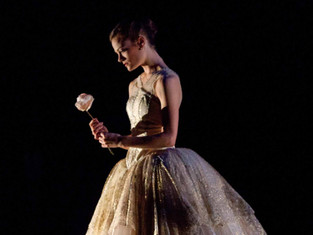David Bintley
Birmingham Royal Ballet
Lowry Lyric, Salford
20 March 2019 - 23 March 2019; 2hr 5min, inc 20-minute interval


Back for a fourth visit, Bintley’s take on the old fairytale (seen here in 2004, 2012, and 2014) is still a crowd-pleaser and well worth including in his bowing-out season as director of Birmingham Royal Ballet.
It’s not the Disney version. No Gaston, no angry villagers, no terpsichorean teapots or frolicking furniture (though there are some magic, self-moving sets and gadgets). Bintley decided to make it about man’s abuse of the natural world – so the Beast has a pre-story in which he gets made beastly for hunting foxes, and his castle is full of similarly-enchanted people turned into animals, while Belle is led to enter this strange world by a flock of birds and her own liking for flowers plucked from their stems (a good thing, apparently – but then that part of the story is traditional and pre-dates environmental awareness).
The first act was tightened up in 2014 but still has a lot of narrative to pack in, because of the double back-story built into this interpretation of the tale – and there’s more towards the end of the piece, too, because we’re supposed to see a ‘redemption’, not just of the Beast by being transformed back into a prince, but of his whole world too, as harmony between man and nature is restored.
The love story is there, but strangely passionless - at least as it appeared to me last night. Belle has a good time dancing with the Repulsive One at his ball, which begins the second act, but loses her bottle and runs off back to daddy when he makes his proposal. She seems to have a rival in the ‘Wild Girl’, who figures in the story from the start and, when the transformation does come, seems distinctly underwhelmed by Mr Beast’s new look. He doesn’t appear to show much sign of being willing to suffer for her sake either (something the Disney story does catch, giving the thing a degree of psychological depth in their version).
Bintley livens up his rather heavy interpretive gloss by giving us a picture of Belle and her sisters’ home life much akin to Cinderella’s, with a comic suitor, be-snouted, called Monsieur Cochon, who pops up in both acts – the second time as pure comic relief. The natural world comes to life in two big corps de ballet numbers, the first a positive murmuration as the birds of the air lead Belle to the castle, and the second the Beast’s Big Ball, where the animals hold sway and get quite frisky in the middle section of the Tchaikovsky-ian waltz provided by composer Glenn Buhr.
So it’s all visually fascinating (and almost universally dark and dim in Philip Prowse’s design and Mark Jonathan’s lighting), and the music is pleasantly pastiche-like of many popular 20th-century scores.
The dancing was, of course, high quality, with Yvette Knight a pure English rose as Belle, and Brandon Lawrence a fierce and powerful Beast, with other roles danced with great distinction.








